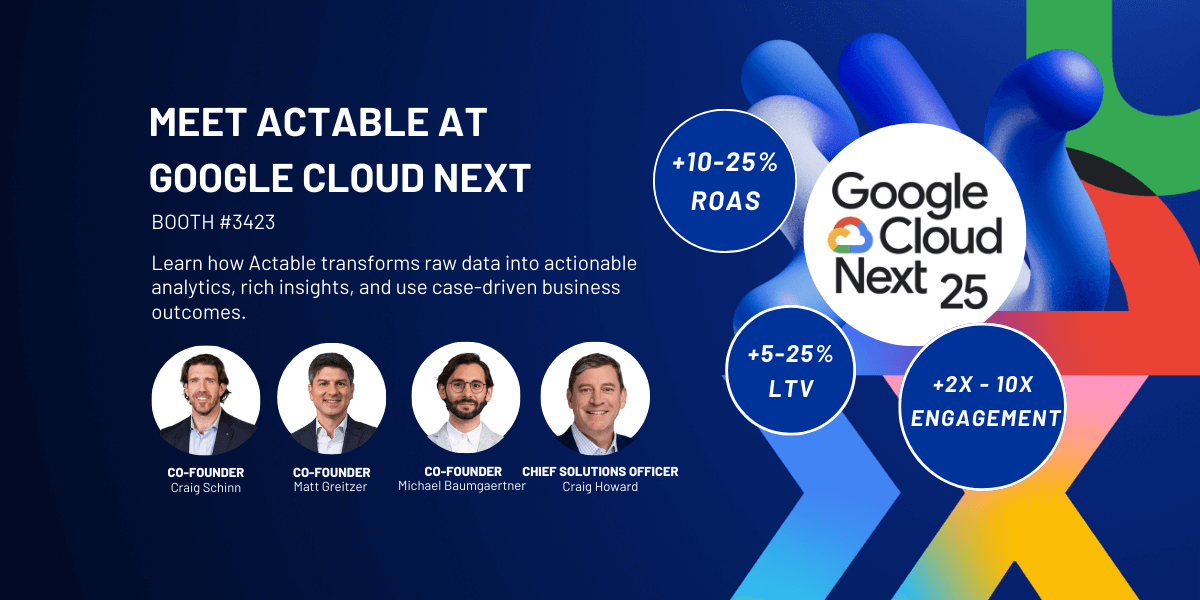In a recent project with a new client, Actable considered the impact of adding a Customer Data Platform (CDP) to the client’s marketing stack. A project member questioned whether or not that client could effectively deploy a CDP. Could their marketing team actually use one? Do CDPs actually break enterprise marketing teams? We thought it might be worth putting our thoughts to paper.
I’ll cut to the chase. No, CDPs don’t typically break enterprise marketing teams. They’re usually already broken. I say this as a lifelong marketer – with undergrad and MBA concentrations in marketing; with over 20 years of professional experience across consulting, agency, client, technology, and now entrepreneur. Too often, marketing departments are broken – with or without CDPs. A CDP puts a microscope to those flaws and exposes them.
Here’s what we think is wrong most commonly:
- The Skill Gap Persists. The marketing team lacks the fundamental marketing technology skills to thrive in today’s tech-driven marketing ecosystem. Advertising agencies, once the primary feeders of great marketing talent into client organizations, are generally providing commoditized services like buying ads on the oligopoly landscape of digital media. Few agencies have depth in CRM, customer experiences that leverage true 1st party customer data, and hands-on-keyboard marketing technology experience. Yet, many clients expect a “no-code” or “easy-to-use” solution. Marketing today is a technology discipline, rooted in digital experiences. The client marketing team has to be comfortable with that. I contend that the marketing technology solutions that exist today are easy to use for the skilled user who has a complete vision of data & the connected customer experiences. An upskilling of the marketing departments at client organizations is necessary in order to drive more value from the martech stacks that are a capstone to years-long digital transformation initiatives.
- Great Creative Alone JUST doesn’t DO IT. While miracles can happen, great creative no longer wins the day with an inspiring 30 second spot. Great customer experiences & great product are much more the focus for winning organizations. To speak to individuals, much more targeting and scalability must be achieved to create experiences. Most clients we work with still struggle with this. This is because it’s not solely a marketing function. The product and the technical staff that support digital products must work to make the data generated usable and actionable for marketing to create and further great customer experiences.
- Marketing & Technology Departments Are Out of Synch. The technology team is picking a CDP that doesn’t have clear marketing buy-in. Or the marketing team wants a solution without understanding the impact on other technologies in which technical teams have made enormous investments. Success with 1st party customer data is a cross-functional endeavor. If the client doesn’t have their data engineers, analysts, product engineers, and marketers aligned, the efforts will likely fail to reach complete potential.
- Analytics & Data Savviness Are Lacking. Famed management consultant, thinker, and author Peter Drucker wrote “the aim of marketing is to know and understand the customer so well the product or service fits him and sells itself.” Yet, the marketing team is often unfamiliar with the data in the data warehouse, and oftentimes in the ESP. They’re often lacking in basic SQL and data querying skills to comb this data for insights. In other cases, the marketing team is well intentioned with semi-technical marketing operations personnel, but the team may be prevented from gaining real hands-on experience with the data. As important customer data is often locked away by a privacy/compliance-oriented IT Team. Yes, some privacy concerns may exist; but much can be done to protect customer data AND enable marketers to create great customer experiences. Yet, marketing often doesn’t have access to even a sliver of customer data aside from aggregated reporting. How can these marketers know and understand the customer so well without access to these key pieces of intelligence?
- Data Science Is Too Often a Standalone Discipline. Recent reports suggest that roughly 9 in 10 data science projects never get deployed to production. The vast majority of data scientist time is cleaning up messy data. We have all seen the impact of good models successfully deployed in case studies. Why are these the case studies so often read but seem to infrequently be the day-to-day reality of marketing departments today? Generally, even the best predictive models are not seamlessly deployed. Models are too disconnected from the marketing ecosystem that drives customer experiences. Thus, the critical job of decisioning in customer experiences is often relegated to the out-of-the-box data science provided by the marketing technology providers & advertising oligopolies at best…at worst, not used whatsoever.
- Marketing Departments Are Not Adapting Quickly Enough. Big tech oligopolies Google, Meta, and Apple have everything to gain by posturing on privacy. They have some of the richest 1st party datasets on the planet. And once the marketer’s ability to leverage 3rd party data is destroyed, big tech will be left standing, willing to monetize the “1st party” data they have collected across your devices and their digital products. By eliminating or greatly stunting the ability to use 3rd party data, marketers are left with more limited targeting options. Many marketers have simply failed to adapt to these long-telegraphed changes. Most don’t have full access to 1st party data…see marketing / tech alignment above. Then, many who have a CDP – which allows onboarding of audiences to the likes of Google, Facebook, Amazon — often don’t know how to deploy the data or are uncomfortable doing so. See Skill Gap above.
All hope is not lost. There is still a great deal that enterprises can do to boost their data literacy and use that data literacy to drive more relevant and impactful customer experiences.
- Hire real specialists. Find people who know how to leverage data in marketing experiences. I’m not talking about showing fancy graphs about who the customer is. That skill is valuable; however, it doesn’t necessarily correlate with driving action from data in a hands-on way. Real specialists are people who can leverage enterprise data models to deploy seamless, real-time experiences across myriad channels. Real specialists understand the data needed for use cases and can link data collection, analytics, and activation cohesively.
- Invest in data literacy. Ensure that your marketing team understands the data about your customers at a field-by-field level. Ensure that your organization has stands & definitions for key customer actions. Make these consistent & deployable across the organization. Ensure that these are consistent with a data governance framework for how data can and should be used.
- Align data assets. Ensure that key data is collected on-site and mapped in such a way to be usable by the marketing department. For example, the website and mobile apps are not just for branded experiences. Ensure that your marketing team can access, query, and segment key user data in its everyday tools. That’s a fixable problem if not…there are literally hundreds of off the shelf tools for that. Make it a priority. It generally pays off 10x or more, especially in the hands of experts.
- Have a testing plan. Your Analytics Roadmap should align with your Use Case Roadmap. Ensure that your teams are testing & learning from the customer data they have. For example, one Actable client wanted to achieve higher 90-day monetization of new-to-file subscribers. Actable worked to establish a roadmap of tests using 1st party customer data that helped the client to improve monetization by over 30%.
- Look for rapid time-to-value technology enablers. Some CDPs offer exceptional time-to-value for deploying 1st party customer data, but implementation frictions can be significant. Some organizations may consider reverse ETL solutions which may significantly accelerate adoption of sophisticated targeting schemes. Leveraging existing data infrastructure may be more privacy-compliant and provide quicker time-to-value in many cases.
If the above seems unrealistic or unachievable, consult real experts. I’m proud to say that my company, Actable, has an expert, cross-functional team who can help you clients move more quickly to this impending change.









